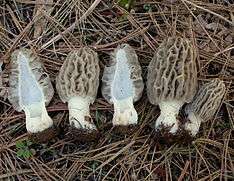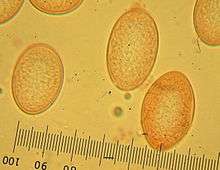Morchella tridentina
Morchella tridentina is a species of fungus in the family Morchellaceae, referred to as the mountain blond or western blond morel in North America, but also found in the Mediterranean basin. It has conical, grey to buff fruit bodies that grow up to 20 cm (7.9 in) tall and 5 cm (2.0 in) wide. Recent molecular and morphological studies have also shown M. tridentina to be conspecific to M. frustrata, M. quercus-ilicis, M. elatoides, M. elatoides var. elegans and M. conica var. pseudoeximia.
| Morchella tridentina | |
|---|---|
 | |
| Scientific classification | |
| Kingdom: | |
| Division: | |
| Class: | |
| Order: | |
| Family: | |
| Genus: | |
| Species: | M. tridentina |
| Binomial name | |
| Morchella tridentina Bres., 1892 | |
| Synonyms[1][2][3] | |
| |
Taxonomy
Morchella tridentina was first described by Giacomo Bresadola in 1892 in a work on fungi found in the region of Trento in Italy, and it has retained the same name up to the present day.[3][4] The species name derives from the Latin word for Trento, "Tridentum".[5]
The American species Morchella frustrata was described as new to science in a 2012 publication by Michael Kuo and colleagues. The report resulted from the Morel Data Collection Project,[6] which aimed to clarify aspects of the biology, taxonomy and distribution of North American Morchella, and described 14 new morel species (without, however, checking in detail the correspondence with existing European names[2]). The type locality was in Placer County, California.[7] In a study the year before, this morel was referred to as "Mel-2", which was a phylogenetic species, defined by DNA sequence rather than morphological characteristics.[8] It was given the common name "mountain blond morel".[9] The specific epithet frustrata refers to the "frustrating combination of black and yellow morel features that characterize the species."[7]
In two subsequent studies, however, Richard and colleagues (in 2014) and Loizides and colleagues (in 2015) used DNA analysis to determine that this species is identical to morels collected in southern Europe, matching the original 1892 description of Morchella tridentina by Bresadola. The latter name therefore takes precedence and M. frustrata is actually a synonym of M. tridentina.[1][2]
Description
Morphology
The fruit bodies are often rufescent and 9–20 cm (3.5–7.9 in) high. The conical cap is 4–6 cm (1.6–2.4 in) high and 2.5–4 cm (1.0–1.6 in) wide at the widest point. The cap surface features pits and ridges, which are formed from the intersection of 16–22 primary vertical ridges and few shorter, secondary vertical ridges, with frequent, sunken, horizontal ridges. The cap is attached to the stipe with a distinct sinus about 2–4 mm deep and 2–4 mm wide. The smooth, splitting ridges remain persistently pale throughout the maturity process, easily distinguishing this species from other species in section Elata, or black morels, which have ridges that typically darken with age.[2] Pits are usually elongated vertically. They are smooth, dull grayish to pale yellowish or nearly whitish when young, later becoming pale tan to pale pinkish tan. The stipe is 2–6 cm (0.8–2.4 in) high by 1–4 cm (0.4–1.6 in) wide and is more or less equal in width throughout its length or sometimes thicker at the base. Its whitish surface is smooth or finely mealy with whitish granules. The flesh is whitish and measures 1–2 mm thick in the hollow cap and the sterile inner surface of the cap is whitish and pubescent (having soft, short and erect "hairs").[7]

The ascospores are smooth, elliptical, and measure 20–26 by 13–18 µm. The asci (spore-bearing cells) measure 225–330 by 15–25 µm and are cylindrical, eight-spored, and hyaline (translucent) when mounted in dilute (2%) potassium hydroxide (KOH). The paraphyses are cylindrical to capitate or moniliform, measuring 95–250 long by 10–25 µm wide, and are septate. Their tips are rounded to somewhat club-shaped or infrequently somewhat fuse-shaped. Elements on the sterile ridges are 50–175 by 12.5–20 µm, and septate. The terminal cells are club-shaped or nearly so.[7]
Edibility
See the article on the genus Morchella for details of edible characteristics, which are presumed to be the similar in all morels. In general, morels should not be eaten raw, as they can trigger allergic reactions in susceptible individuals. Their flavor is enhanced after they are fried, stuffed, or dried, and so is their safety for eating.[10][11]
Similar species
This species is very similar to Morchella rufobrunnea, another rufescent, cosmopolitan species with pale colours, which is nonetheless found in urban and suburban areas. The latter is distinguished by an adnate cap lacking a sinus and a distinct dark pruinescence on the stem, more pronounced in young fruit bodies.[2] Due to its similar light coloration, M. tridentina may also be confused with Morchella esculentoides; as Kuo states, "it looks like a black morel with the colors of a yellow morel."[12] The vertically arranged pits and ridges, as well as the slight indentation where the cap meets the stem on M. tridentina, however, more closely resemble the black morels such as M. elata.[7] M. snyderi is somewhat similar in appearance to young specimens of M. tridentina, but mature specimens of the former species can be distinguished by the brown to black ridges on the cap, and the ridged and pocketed stipe.[12]
Despite its light color, M. tridentina belongs to the Elata clade along with other black morels, including M. tomentosa and M. angusticeps.[7]
Habitat and distribution
Morchella tridentina fruit bodies grow solitary, scattered, or in small groups in spring, in mountainous forests and maquis. The exact trophic status of the fungus is not yet known with certainty, but it is suspected to be facultatively mycorrhizal or biotrophic. Tree species associated with the fungus include pacific madrone (Arbutus menziesii), oaks (Quercus spp.), Douglas fir (Pseudotsuga menziesii), ponderosa pine (Pinus ponderosa), sugar pine (Pinus lambertiana), and white fir (Abies concolor).[7] In Europe it is often found with holm oak (Quercus ilex), strawberry trees (Arbutus andrachne), olive trees (Olea europaea), Spanish fir (Abies pinsapo), Silver fir (Abies alba) and Scot's pine (Pinus sylvestris).
Although it was originally hypothesized that collections of M. tridentina from Turkey might recently have been introduced from North America,[13] numerous collections reported since from remote and undisturbed areas in the Mediterranean and the Alps (including Bresadola's original collection from Trentino), suggest a long-time and well-established presence of this species in Europe.[2][14] Kuo suggests that it might be also widely distributed in western North America, but so far it has only been confirmed to be present in Oregon and California.[12]
References
- Richard, Franck; Bellanger, Jean-Michel; Clowez, Philippe; Courtecuisse, Regis; Hansen, Karen; O'Donnell, Kerry; Sauve, Mathieu; Urban, Alexander; Moreau, Pierre-Arthur (30 December 2014). "True morels (Morchella, Pezizales) of Europe and North America: evolutionary relationships inferred from multilocus data and a unified taxonomy". Mycologia. 107 (2): 359–382. doi:10.3852/14-166. PMID 25550303. 14-166.
- Loizides M, Alvarado P, Clowez P, Moreau P-A, de la Osa LR, Palazon A (2015). "Morchella tridentina, M. rufobrunnea, and M. kakiicolor: a study of three poorly known Mediterranean morels, with nomenclatural updates in section Distantes". Mycological Progress. 14 (3): 13. doi:10.1007/s11557-015-1030-6.
- "the Morchella tridentina page". Species Fungorum. Royal Botanic Gardens Kew. Retrieved 2020-05-18.
- Bresadola, G.; Quélet, L. (1882). Fungi Tridentini novi vel nondum delineati, descripti et iconibus illustrati (in Latin). 2. Trento. p. 65. Retrieved 2020-05-18.
- "Tridentum. The underground town". Cultura Trentino. Retrieved 2020-05-18.
- Kuo M. "The Morchellaceae: True Morels and Verpas". MushroomExpert.com. Retrieved 2013-12-16.
- Kuo M, Dewsbury DR, O'Donnell K, Carter MC, Rehner SA, Moore JD, Moncalvo JM, Canfield SA, Stephenson SL, Methven AS, Volk TJ (2012). "Taxonomic revision of true morels (Morchella) in Canada and the United States". Mycologia. 104 (5): 1159–77. doi:10.3852/11-375. PMID 22495449.
- O'Donnell K, Rooney AP, Mills GL, Kuo M, Weber NS, Rehner SA (2011). "Phylogeny and historical biogeography of true morels (Morchella) reveals an early Cretaceous origin and high continental endemism and provincialism in the Holarctic". Fungal Genetics and Biology. 48 (3): 252–65. doi:10.1016/j.fgb.2010.09.006. PMID 20888422.
- Pilz D, McLain R, Alexander S, Villarreal-Ruiz L, Berch S, Wurtz TL, Parks CG, McFarlane E, Baker B, Molina R, Smith JE (March 2007). Ecology and management of morels harvested from the forests of western North America. General Technical Report PNW-GTR-710. Portland, Oregon: U.S. Forest Service Pacific Northwest Research Station.
- Kuo M. (2005). Morels. Ann Arbor, Michigan: University of Michigan Press. p. 173. ISBN 978-0-472-03036-1.
- Viess (May 2015). "California Morels: A Delicious Enigma!". Bay Area Mycological Society. Retrieved 2020-05-19.
- Kuo M. (November 2012). "Morchella frustrata". MushroomExpert.com. Retrieved 2013-12-15.
- Taşkın H, Büyükalaca S, Hansen K, O'Donnell K (2012). "Multilocus phylogenetics analysis of true morels (Morchella) reveals high levels of endemics in Turkey relative to other regions of Europe". Mycologia. 104 (2): 446–61. doi:10.3852/11-180. PMID 22123659.
- Loizides, Michael; Bellanger, Jean-Michel; Clowez, Philippe; Richard, Franck; Moreau, Pierre-Arthur (2016). "Combined phylogenetic and morphological studies of true morels (Pezizales, Ascomycota) in Cyprus reveal significant diversity, including Morchella arbutiphila and M. disparilis spp. nov". Mycological Progress. 15 (4): 39. doi:10.1007/s11557-016-1180-1.
External links
| Wikimedia Commons has media related to Morchella tridentina. |